“My father was only 45 when he felt tired all the time. We thought it was just work stress. By the time we realized it was his heart failing, the damage was severe. I wish we had known the warning signs earlier.” – Priya from Delhi
Did you know? South Asians have a 4 times higher risk of heart disease than other groups, and many of us develop these problems in our 40s instead of our 60s.
Many of us have heard about heart attacks and heart failure. You might even know someone who has had one of these heart problems. But do you know the difference between them?
For South Asians, knowing this difference could save your life or the life of someone you love. Our community faces higher heart risks than other groups. Many of us get heart disease earlier in life – sometimes 10 years earlier than other people, according to the American Heart Association.
Let’s learn the difference between these two heart conditions in simple terms, so you can protect yourself and your loved ones.
Don't Mix These Up: The Basic Difference
Think of your heart as the engine of your body. It can have different types of problems:
Heart Attack: A sudden blockage – like a traffic jam in one of the heart’s roads (arteries).
Heart Failure: A weak pump – the heart is still working but not strong enough to do its full job.
What is a Heart Attack?
A heart attack happens suddenly when blood flow to part of your heart gets blocked. This is usually caused by a clot in one of the heart’s blood vessels.
What happens during a heart attack:
- A blood vessel that feeds your heart muscle gets blocked
- That part of your heart can’t get oxygen
- The blocked area starts to die if not treated quickly
- This is a medical emergency – every minute counts!
Think of it like: A clogged pipe that suddenly stops water from reaching part of your garden. That section starts to die if you don’t fix the clog quickly.
What is Heart Failure?
Despite its name, heart failure does not mean your heart has stopped working. It means your heart has become weak and can’t pump blood as well as it should.
What happens during heart failure:
- The heart becomes weak, stiff, or both
- It can’t pump enough blood to meet your body’s needs
- Your body tries to compensate by:
- Making your heart beat faster
- Holding onto water and salt (causing swelling)
- Redirecting blood to vital organs and away from less important areas
- This usually develops slowly, over months or years
- While not always an immediate emergency like a heart attack, heart failure is a serious condition that needs medical care
Types of heart failure you should know about:
- Left-sided failure: The most common type. The left side of your heart can’t pump enough blood to your body. This causes breathing problems and tiredness.
- Right-sided failure: The right side can’t pump enough blood to your lungs. This often causes swelling in your legs, ankles, and belly.
- Systolic failure: The heart muscle can’t squeeze strongly enough.
- Diastolic failure: The heart muscle becomes stiff and can’t relax properly between beats.
Think of it like: A water pump that’s worn out and doesn’t have enough power to push water through your whole house. Some rooms might get less water than they need.
Why South Asians Need to Pay Extra Attention
Our community has special reasons to be careful about heart health:
- Earlier disease: Heart problems can start 10 years earlier in South Asians compared to other groups, as published in the Journal of the American College of Cardiology
- Different fat patterns: We often store fat around our organs and belly, which increases heart risks even if we’re not overweight
- Higher diabetes rates: Diabetes damages blood vessels and makes heart problems more likely
- Cultural factors: Our traditional diets can be high in oils, ghee, and fried foods
- Symptom awareness: Many of us don’t recognize symptoms or may ignore them
Did you know? According to recent studies from the Mayo Clinic, even young South Asians with normal body weight can have high risk for heart disease because of where we store fat in our bodies.
Look Out for These Signs
When to Call Help Right Away (Possible Heart Attack):
- Chest pain, pressure, or squeezing that lasts more than a few minutes
- Pain spreading to your jaw, neck, back, or arm (especially the left arm)
- Cold sweat with nausea or dizziness
- Severe shortness of breath
Important note for women and elderly people: The Cleveland Clinic warns that you might not always feel classic chest pain. Watch for unusual tiredness, shortness of breath, or stomach pain that comes on suddenly.
When to See a Doctor Soon (Possible Heart Failure):
- Getting out of breath with normal activities
- Trouble breathing when lying flat
- Swollen feet, ankles, or legs
- Feeling unusually tired all the time
- Frequent coughing, especially when lying down
Prevention is Better Than Treatment
For both conditions, these steps can help:
- Get regular check-ups: Even if you feel fine, get your blood pressure, blood sugar, and cholesterol checked
- Take medicines as prescribed: Don’t stop without talking to your doctor
- Watch what you eat: Reduce salt, oil, and sugary foods
- Stay active: Even walking 30 minutes daily helps
- Know your family history: Tell your doctor if heart problems run in your family
Simple tip: The National Heart, Lung, and Blood Institute recommends measuring your waist. For South Asians, waist sizes over 35 inches (women) or 37 inches (men) increase heart risk, even at normal weight.
Talk to Your Family — Today!
Even if you feel okay, your heart might be struggling in silence. Many heart problems don’t show obvious signs until they’re serious.
Heart disease often runs in families. If you have heart issues, your brothers, sisters, children, and parents might be at risk too. Starting the conversation could save their lives.
Take Action Now:
- Schedule a heart check-up this week — even if you feel fine
- Share this article with at least 3 family members
- Start a family health chat on WhatsApp about heart health
- Make one small change today — like a 10-minute walk after dinner
Remember: South Asian hearts need extra care. The American Heart Association confirms we’re at higher risk, but we can change our future with early action and awareness.
Don’t wait for symptoms. The best time to check your heart health is now.
Sources:
- American Heart Association. “South Asians and Heart Disease.” https://www.heart.org/en/health-topics/heart-attack/warning-signs-of-a-heart-attack/heart-attack-symptoms-in-women
- Journal of the American College of Cardiology. “South Asians and Cardiovascular Disease: The Hidden Threat.” https://www.jacc.org/doi/full/10.1016/j.jacc.2018.04.059
- Cleveland Clinic. “Heart Attack vs. Heart Failure: What’s the Difference?” https://health.clevelandclinic.org/heart-attack-vs-heart-failure
- National Heart, Lung, and Blood Institute. “Heart Failure.” https://www.nhlbi.nih.gov/health-topics/heart-failure
Mayo Clinic. “Heart Attack.” https://www.mayoclinic.org/diseases-conditions/heart-attack/symptoms-causes/syc-20373106




